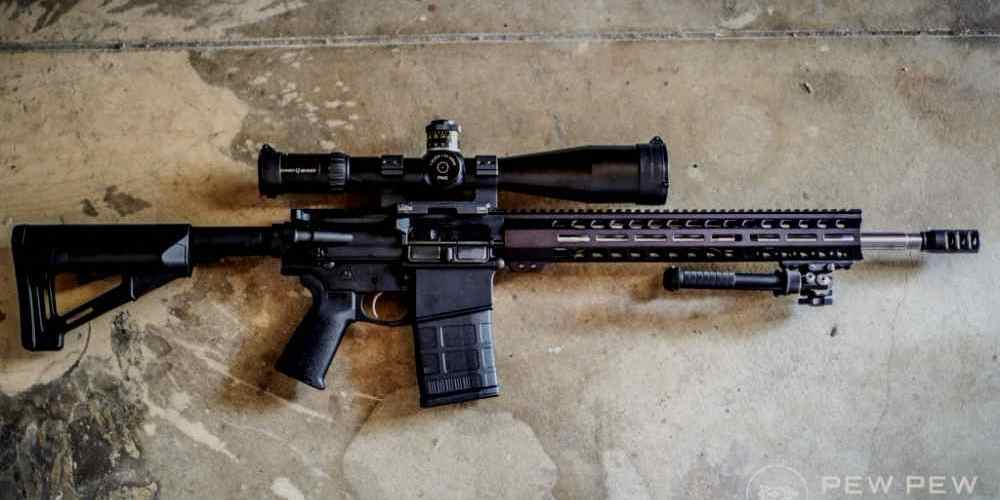“Precision and safety, every shot counts.”
Proper Grip and Stance Techniques
When it comes to shooting an AR-15 at the range, having proper grip and stance techniques is essential for accuracy and safety. Whether you are a beginner or a seasoned shooter, mastering these fundamentals will improve your shooting skills and overall experience.
Let’s start with the grip. The grip is how you hold the rifle, and it plays a crucial role in controlling recoil and maintaining accuracy. To achieve a proper grip, place your dominant hand on the pistol grip with your index finger resting on the trigger. Your grip should be firm but not too tight, allowing for natural movement and control of the rifle.
Next, wrap your non-dominant hand around the handguard, positioning it as far forward as possible without interfering with the barrel. This two-handed grip provides stability and control, reducing muzzle rise and improving follow-up shots. Make sure your thumbs are pointing forward and not overlapping, as this can cause malfunctions and discomfort.
Now, let’s talk about stance. Your stance is how you position your body in relation to the target and the rifle. A proper stance provides a stable platform for shooting, allowing you to absorb recoil and maintain balance. The most common stance for shooting an AR-15 is the Weaver stance.
In the Weaver stance, stand with your dominant foot slightly back and your non-dominant foot forward, creating a slight angle to the target. Bend your knees slightly and lean forward at the waist, distributing your weight evenly between your feet. This stance helps absorb recoil and allows for quick target acquisition.
Another important aspect of your stance is your shoulder placement. Your dominant shoulder should be firmly pressed into the stock of the rifle, creating a solid anchor point for stability. Keep your head upright and aligned with the rifle’s sights, maintaining a clear line of sight to the target.
Transitioning smoothly from grip to stance, remember to keep your body relaxed and your movements fluid. Tension in your muscles can affect your accuracy and cause fatigue over time. Practice breathing techniques to help control your heart rate and maintain focus while shooting.
As you practice these grip and stance techniques, pay attention to your body alignment and adjust as needed. Experiment with different hand placements and foot positions to find what works best for you. Consistency is key in developing muscle memory and improving your shooting skills.

In conclusion, mastering proper grip and stance techniques is essential for shooting an AR-15 at the range. These fundamentals provide stability, control, and accuracy, enhancing your overall shooting experience. Remember to practice regularly and seek guidance from experienced shooters to refine your skills. With dedication and attention to detail, you can become a proficient AR-15 shooter and enjoy the sport to its fullest potential.
Sight Alignment and Sight Picture
When it comes to shooting an AR-15 at the range, one of the most important aspects to focus on is sight alignment and sight picture. These two elements are crucial for accuracy and consistency in your shooting. Let’s dive into some best practices to help you improve your skills in this area.
First and foremost, it’s essential to understand what sight alignment and sight picture actually mean. Sight alignment refers to the relationship between the front and rear sights of your firearm. The front sight should be centered in the rear sight notch, with an equal amount of space on either side. This alignment ensures that your shots will be on target.
Sight picture, on the other hand, involves aligning your sights with the target. The front sight should be placed directly on the target, with the top of the front sight level with the top of the rear sight. This alignment allows you to accurately aim at your target and make precise shots.
To achieve proper sight alignment and sight picture, it’s important to have a consistent shooting stance and grip. Your stance should be stable and balanced, with your feet shoulder-width apart and your body facing the target. Your grip on the firearm should be firm but not overly tight, allowing you to control the recoil and maintain control of the weapon.
As you bring the firearm up to aim, focus on aligning the front and rear sights while keeping your eye on the target. It’s crucial to maintain a steady hold on the firearm and avoid any unnecessary movement that could throw off your alignment. Take a deep breath, exhale slowly, and squeeze the trigger smoothly to make your shot.
Practice is key when it comes to improving your sight alignment and sight picture. Spend time at the range working on these fundamentals, focusing on consistency and precision in your shots. Start at a closer distance and gradually work your way out to longer ranges as you become more comfortable with your shooting skills.
Another helpful tip for improving your sight alignment and sight picture is to use a sight alignment tool or laser bore sighter. These tools can help you ensure that your sights are properly aligned and give you a visual reference for making adjustments. They can be especially useful for beginners who are still learning how to align their sights correctly.
In conclusion, sight alignment and sight picture are essential components of accurate shooting with an AR-15. By focusing on these fundamentals and practicing regularly, you can improve your shooting skills and become a more proficient marksman. Remember to maintain a consistent stance and grip, align your sights with the target, and practice proper breathing and trigger control. With dedication and practice, you can master the art of shooting with precision and confidence.
Trigger Control and Follow Through
When it comes to shooting an AR-15 at the range, there are several key factors that can greatly impact your accuracy and overall shooting experience. One of the most important aspects to consider is trigger control and follow through. Proper trigger control is essential for achieving consistent and accurate shots, while follow through ensures that you maintain control of your firearm after the shot is fired.
To begin, let’s discuss trigger control. Trigger control refers to the way in which you manipulate the trigger of your AR-15 to fire a shot. It is important to apply steady pressure to the trigger without jerking or flinching, as this can cause your shots to be off target. One of the best practices for trigger control is to use the pad of your index finger to pull the trigger straight back towards the rear of the firearm. This helps to ensure a smooth and consistent trigger pull, which is essential for accuracy.
Another important aspect of trigger control is to maintain proper finger placement on the trigger. Your finger should be positioned in such a way that it does not interfere with the movement of the trigger or cause it to be pulled to one side. It is also important to avoid placing too much pressure on the trigger, as this can lead to a jerky or uneven trigger pull. Instead, focus on applying steady pressure to the trigger until the shot breaks.
Once you have mastered proper trigger control, it is important to focus on follow through. Follow through refers to the actions you take immediately after firing a shot, and it is crucial for maintaining control of your firearm and ensuring accuracy. One of the best practices for follow through is to maintain your shooting position and sight picture after the shot is fired. This helps to ensure that you are able to track the shot and make any necessary adjustments for subsequent shots.
In addition to maintaining your shooting position, it is important to keep your finger off the trigger after firing a shot. This helps to prevent accidental discharges and ensures that you are in control of your firearm at all times. It is also important to keep your eyes on the target and follow the path of the bullet to assess your shot placement. This can help you make adjustments to your aim and improve your accuracy over time.
Overall, proper trigger control and follow through are essential for achieving consistent and accurate shots with your AR-15 at the range. By focusing on these key aspects of shooting technique, you can improve your marksmanship skills and enjoy a more rewarding shooting experience. Remember to practice regularly and seek guidance from experienced shooters to continue honing your skills. With dedication and attention to detail, you can become a proficient AR-15 shooter and enjoy the thrill of hitting your target with precision and accuracy.
Recoil Management and Recovery
When it comes to shooting an AR-15 at the range, one of the most important aspects to consider is recoil management and recovery. Recoil refers to the backward movement of the firearm after firing a round, and how well you can control this recoil can greatly impact your accuracy and overall shooting experience.
One of the best practices for recoil management is to have a proper stance. Your stance should be stable and balanced, with your feet shoulder-width apart and your body slightly leaning forward. This will help absorb some of the recoil and allow you to maintain control of the firearm. Additionally, gripping the AR-15 firmly with both hands will also help reduce recoil and improve your accuracy.
Another important aspect of recoil management is controlling your breathing. It’s crucial to take deep breaths and exhale slowly before taking your shot. This will help you stay calm and focused, which in turn will improve your ability to manage recoil effectively. Remember to also follow through with your shot, maintaining your grip and stance even after the round has been fired.
In terms of recovery, it’s important to quickly reacquire your target after each shot. This involves bringing the firearm back on target as soon as possible, so you can take your next shot with minimal delay. Practicing this skill will help you become more efficient and accurate in your shooting.
One technique that can help with recoil recovery is the “reset and squeeze” method. After firing a shot, release the trigger just enough to reset it, then squeeze it again to take your next shot. This will help you maintain control of the firearm and reduce the time it takes to get back on target.
It’s also important to practice proper follow-through after each shot. This involves keeping your eyes on the target and maintaining your grip and stance until you are ready to take your next shot. By doing this consistently, you will develop muscle memory and improve your overall shooting technique.
In addition to these techniques, it’s important to regularly practice shooting drills that focus on recoil management and recovery. This will help you become more comfortable and confident with your AR-15, allowing you to shoot more accurately and efficiently.
Overall, mastering recoil management and recovery is essential for becoming a skilled AR-15 shooter. By practicing proper stance, breathing control, and follow-through, you can improve your accuracy and shooting speed. Remember to stay focused and disciplined in your training, and you will see improvements in your shooting skills over time.
Safety Measures and Range Etiquette
When it comes to shooting at the range with an AR-15, safety should always be the top priority. Whether you are a seasoned shooter or a beginner, following best practices for safety measures and range etiquette is essential to ensure a safe and enjoyable shooting experience.
One of the most important safety measures when shooting an AR-15 at the range is to always treat the firearm as if it is loaded. Even if you know for sure that the gun is unloaded, always keep the muzzle pointed in a safe direction and your finger off the trigger until you are ready to shoot. This simple rule can prevent accidents and injuries.
Another key safety measure is to know your target and what is beyond it. Before taking a shot, make sure there is a safe backstop to catch the bullets. This will prevent any stray bullets from causing harm to people or property. Additionally, be aware of your surroundings and never shoot in the direction of other shooters or range personnel.
Range etiquette is also important when shooting at the range with an AR-15. Always follow the rules and regulations of the range, including wearing ear and eye protection at all times. This will protect your senses from the loud noise and debris that can be produced when shooting a firearm.
When shooting at the range, it is important to be considerate of other shooters. Wait your turn and be patient if the range is busy. Do not interfere with other shooters or distract them while they are shooting. Always be respectful and courteous to others at the range.
Proper gun handling is another important aspect of range etiquette. Always keep your firearm pointed downrange and never point it at anyone, even if it is unloaded. When not in use, keep your AR-15 in a safe and secure location, such as a gun case or a gun rack.
When shooting at the range, it is important to follow the range commands and instructions of the range safety officers. They are there to ensure the safety of all shooters and maintain order on the range. Listen carefully to their instructions and follow them without question.
In conclusion, shooting at the range with an AR-15 can be a fun and rewarding experience, but it is important to always prioritize safety and range etiquette. By following best practices for safety measures and range etiquette, you can ensure a safe and enjoyable shooting experience for yourself and others at the range. Remember to always treat your firearm with respect, be considerate of others, and follow the rules and regulations of the range. Happy shooting!




